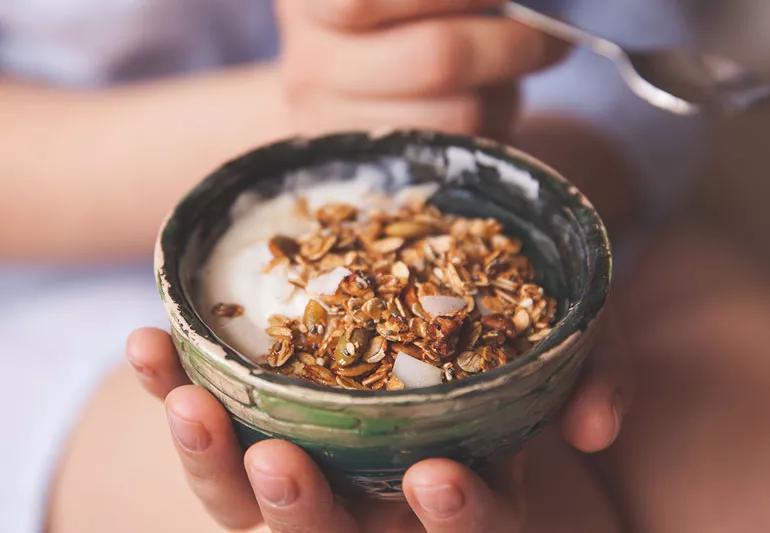A registered dietitian gives tips and diet help

If you’ve ever felt a little woozy after a meal, maybe a little shaky with a touch of sweating or nausea, it’s possible you’ve experienced an episode of reactive hypoglycemia.
Advertisement
Cleveland Clinic is a non-profit academic medical center. Advertising on our site helps support our mission. We do not endorse non-Cleveland Clinic products or services. Policy
While it may seem alarming when it happens, there’s a good explanation for what’s happening to your body. To better understand what’s going on and how you can treat and prevent future episodes, we talked to registered dietitian Julia Zumpano, RD.
Reactive hypoglycemia occurs when your body experiences low blood sugar after a meal. “It typically occurs about 2 hours after a meal,” says Zumpano, “and can sometimes even happen up to 4 hours after eating.”
It’s important to note that it’s different than hypoglycemia, too. “Hypoglycemia is related to a fasting state when you haven’t eaten anything for an extended period,” she adds. “And your blood sugar naturally drops below what’s considered a normal range.” People who have diabetes or impaired fasting glucose are more prone to experiencing hypoglycemia.
While reactive hypoglycemia is different than hypoglycemia, they share similar symptoms, including:
While we know what causes hypoglycemia, the cause of reactive hypoglycemia remains a bit of a mystery, says Zumpano. “Alcohol and high sugar intake are potential triggers for some, but the exact cause is still unknown,” she notes.
Advertisement
“Simple carbohydrate foods like white rice, white pasta, potatoes, white bread, bakery items such as cake, pastries, pancakes or waffles can also lead to this reaction,” she adds. Simple sugars, such as candy, sweetened drinks, honey and table sugar can contribute to as your body breaks them down to sugar immediately.
“Because those foods are broken down and digested into glucose so fast, they cause a quick spike in your blood sugar which then plummets just as quickly, leaving you prone to reactive hypoglycemia,” Zumpano says.
First, cutting back on those foods that can trigger reactive hypoglycemia is a big step towards treating regular occurrences. But removing those simple carbs and simple sugars – from brown sugar to sugar-heavy drinks – can help curb those incidences.
But equally important is shifting your diet to include foods that are considered low glycemic index foods. “Low glycemic index foods are complex carbohydrates, high in fiber and protein,” explains Zumpano. “These foods create a gradual rise and gradual drop in blood sugar levels as opposed to those spikes.”
Beans are good choices, she says. “Black beans, chickpeas and bean-based pasta are great for getting fiber and protein into your diet.”
Complex carbohydrates include:
When it comes to vegetables, non-starchy is the way to go and Zumpano recommends varying your vegetable choices. Starchy vegetables should be limited in portion (these include potatoes, corn and peas). All other vegetables are considered non-starchy and are good to consume as much as you want.
Cruciferous vegetables like broccoli, Brussels sprouts, cabbage and cauliflower are all really high in fiber,” she adds, “but all vegetables are phenomenal.”
Pairing your complex carbohydrates with a source of protein and healthy fat is also important. “When you add those, it slows down your body’s digestion of carbohydrates even further, preventing that spike.”
Beans are, again, a great source of protein but other options include lean meat or fish, nuts, tofu, low-fat dairy products like cottage cheese or Greek yogurt and eggs or egg whites.
Using extra virgin olive oil, avocado oil or nut- or seed-based oils for cooking can deliver healthy fats to your body, says Zumpano. Use these to cook your lean meats or add to cooked vegetables and salads to make a healthy, delicious combo. Limit high heat cooking (greater than 375 degrees F) with extra virgin olive oil and certain nut and seed oils.
Advertisement
Targeting foods that can deliver all these needs – carbohydrates, protein and healthy fat – at once is also a great way to maintain a good balance, she says. “Nuts are a great example because, depending on what type you’re eating, they feature all three of these and make a great snack that can keep your blood sugar better controlled.”
Zumpano also suggests that if you’re going to be drinking alcohol, be sure to drink with food instead of on an empty stomach.
And eating more often, such as consuming small meals or snacks every two-to-four hours, can also help. “Eating more regularly can help prevent reactive hypoglycemia, so making sure you’re keeping things balanced is good.”
“Be sure to listen to your body, too,” she adds. “Talk to your doctor or healthcare provider if you feel that you may be experiencing the symptoms associated with reactive hypoglycemia. Seek a dietitian to help support you in minimizing the symptoms by changing your diet.”
Advertisement
Learn more about our editorial process.
Advertisement

If you have diabetes, working out soon after eating can help lower your blood sugar

Focus on eating more whole grains, lean proteins, fruits and vegetables, and fewer processed foods and saturated fats

One is a supplement, the other is a prescription medication — both may be useful in managing Type 2 diabetes, but one has more research

This approach is all about eating foods that don’t spike your blood sugar quickly

You can use this index to help identify which foods can cause wild swings in your blood sugar

Diet adjustments and exercise can help, as can asking your doctor about medication changes

Nausea, diarrhea and bloating may be common at first, but more serious signs like dizziness or muscle pain should be addressed immediately

Exercising more, eating healthier and managing weight can significantly improve insulin sensitivity

The best parenting style balances enforcing rules and showing plenty of love

Tips include cutting back on sugar, focusing on exercise and managing stress

It can be harder to let go when you’ve invested time, energy and emotions — but it might be the healthier choice long term